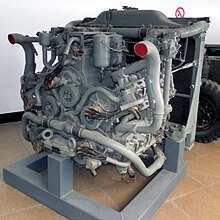In-line radial engine
In-line radial engines are multi - cylinder, water-cooled reciprocating piston engines in which the cylinders are arranged in several rows in a star shape around the crankshaft . The construction consists of a number of in- line engines (only one cylinder bank ), which were combined to form a radial engine . In-line radial engines are often designed for large displacements and high powers in the order of magnitude of about 1000-4000 kW.
Since in-line radial engines accommodate a large number of cylinders in an extremely compact design, they also have a correspondingly high weight- related performance . They are used when high performance is to be provided in a small space, such as B. in aircraft and ship engines . The “Sherman” tank (type M4A4) also had a 30-cylinder “Multibank” in-line radial engine. Other engines include the BMW 803 , Junkers Jumo 222 , Dobrynin WD-4K , Daimler-Benz DB-604 , Rolls-Royce Vulture , Pratt & Whitney R-2060 , Lycoming XR-7755 , Allison X-4520 , Zvezda M503 and the Most powerful and cylinder-richest (56 cylinders) in-line radial engine Zvezda M520 .
Such engines experienced their heyday from around 1940 to 1970. Due to their complex mechanics with a very high number of components, they were later replaced by engines with a maximum of two cylinder banks (in-line, V, and boxer engines ) of appropriate performance classes or by gas turbines .
The multiple radial engine is structurally related , but is typically air-cooled.

